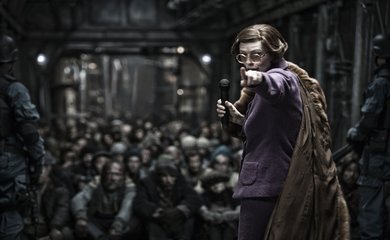Before the Internet stole our ability to dream, school kids looked in wonder through the pages of beautifully illustrated textbooks, littered with hundreds of scientific predictions by 1970s futurologists. Videophones, flying cars and that old favourite, the jetpack whizzed around young brains like the building blocks of a hokey old space opera. The vactrain was another proposed mode of transport, a train that could theoretically reach speeds of between 4000-5000 mph in evacuated tunnels, a transcontinental transport system forging a global network.
In 2031 the closest we’ve got to the vactrain is the Snowpiercer, a nuclear powered train stretching to over 1000 carriages, doomed to circumnavigate the earth, now frozen by a vicious new ice age after an experiment to counter global warming exterminates all life as we know it. Thanks to Wilford, the eccentric genius who created the Snowpiercer, a fragile eco-system survives within its carriages, one consumed by class warfare between the dregs of humanity in the tail section and the rarely seen elites in the front. The closer to the perpetual engine you are the more privilege you receive.
This Gormenghast on wheels is as sleek as a Japanese Bullet train and as blunt as a Soviet armoured locomotive. The interior of the tail is dark and repressive, part Victorian workhouse, part Nazi concentration camp. Armed guards take frequent headcounts and snatch children for unspecified duties near the engine. The tail end is ready for rebellion, plotting in the squalor of a rolling Gulag, one that makes the camp in Alexandr Solzhenitsyn’s, “One Day in the Life of Ivan Denisovich” seem like a Black Sea dacha. Smuggled messages bring hope with their cryptic insight as the great unwashed carefully pick their moment to strike.
Leading the tail with his imposing sense of quiet is Curtis, a man haunted by his past. We can only guess at how horrific the opening months on the Snowpiercer were but we only need look at his eyes to figure that they were worse than anything we could possibly imagine. When Curtis eventually breaks down revealing his trauma we are left aghast at humanity’s capacity to adapt to a barbaric new environment. The double amputee, Gilliam, a man who looks like he is on day release from a leper colony, is grooming Curtis for overall leadership of the tail. Curtis fears his new role but he is savage and intelligent and clearly the only man fit to, “Move forward.”
The face of the elite is the wickedly eccentric Minister Mason, a Northern hybrid of Margaret Thatcher and Mary Whitehouse, false teeth and milk bottle glasses. Her punishments are quick, cruel and severe, delivered with the evangelical zeal of Wilford’s new world order, praising, “The sacred engine. So it is.” Mason is a relic of the Industrial Revolution, taking pleasure in looking for the smallest hands to tend those infernal machines, forcing the youngest children to act as trappers, stopping the build up of toxic fumes, driving capitalism forward with the aid of the lumpenproletariat. Still their power could be waning as the consumables of repression like bullets become, “Extinct.”
As Curtis and his band of misfits forge deeper into the train the horrors and delights unveiled behind each locked door become more surreal, more hideous. The curious world of the Snowpiercer is rife with hooded killers, raised from the butcher’s table in “Jacob’s Ladder,” night vision “Murder On The Orient Express.” This is “Oldboy” to the max, hatchets, blades and billy clubs cutting a bloody swathe through second class. Gunfights rage between the snaking carriages as this land leviathan folds in on itself around curving tracks. If you fancy getting high in a nightclub, or being schooled on the move then the Snowpiercer has it all. This is “Brazil” aboard “Von Ryan’s Express,” with an eclectic international cast similar to “The Cassandra Crossing” and we may never see the like again.
With his adaptation of French graphic novel, “Le Transperceneige,” Korean director Bong Joon-ho has fashioned one of the great works of dystopian cinema. Perhaps looking back on “Snowpiercer” in ten years time maybe even the greatest. There are no easy answers for any of the characters and even less for the audience. Like in “A Clockwork Orange” we have to consider that evil chosen freely is preferable to good brought about by force, yet when that evil can save humanity we need to decide if we are worth saving at all. John Kenneth Galbraith sums up the world of “Snowpiercer” perfectly, “Under capitalism, man exploits man. Under communism, it’s just the opposite.”


This is finally getting a UK and US release thankfully uncut. It was proposed that 20 mins of character development was going to be ditched to play better to midwest American audiences.